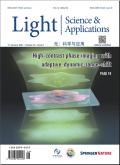Photoenergy harvesting by ammonium molybdate soft hydrogel drops.
IF 23.4
Q1 OPTICS
引用次数: 0
Abstract
Photoenergy harvesting is promising to power Internet-of-Things (IoT) sensors, freeing the limitations of wired power sources or batteries, enabling bio-integrated devices. However, existing photoenergy harvesting systems are restricted to solid or liquid configurations-limiting biocompatibility and space utilization-which makes obtaining flexible, biocompatible, light-harvesting devices a significant challenge. In this paper, inspired by natural ion gradient diffusion in organisms, offering an ion-hydrogel drops-based photoenergy harvesting base on ammonium molybdate. Through the photochemical process of ammonium molybdate, the electric potential of the device is regulated by the altered ion gradient and the redox pairs ( [ Mo 7 O 24 ] 6 - / [ Mo 14 O 46 ] 10 - ), to generate energy. When exposed to excitation light, a photo driven ammonium molybdate-hydrogel photoenergy harvester (PAPH) can generate an open-circuit potential of ~250 mV, and it can still obtain a considerable output power for milliseconds to thousands of seconds after the termination of the initial illumination. The reversible hydrogel droplets network allows for the recovery and fabrication of arbitrary structures of the PAPH. We further demonstrate the scalable PAPH networks can on-demand regulation of cell epithelial growth factor secretion and receptor expression, stimulate the cell proliferation, thereby facilitating biological tissue wound repair. This ionic hydrogel opens a new avenue for flexible, photoenergy harvesting, biocompatible devices.钼酸铵软水凝胶滴的光能收集。
光能收集有望为物联网(IoT)传感器供电,从而摆脱有线电源或电池的限制,实现生物集成设备。然而,现有的光能收集系统仅限于固体或液体结构,这限制了生物相容性和空间利用率,这使得获得灵活的、生物相容性的光收集设备成为一个重大挑战。本文受生物体内天然离子梯度扩散的启发,提出了一种基于钼酸铵离子水凝胶液滴的光能收集方法。通过钼酸铵的光化学过程,通过改变的离子梯度和氧化还原对([Mo 7 O 24] 6 - / [Mo 14 O 46] 10 -)调节器件的电势,产生能量。在激发光下,光驱动的钼酸铵-水凝胶光能收集器(PAPH)可以产生~250 mV的开路电位,并且在初始照明终止后的几毫秒到数千秒内仍然可以获得可观的输出功率。可逆水凝胶液滴网络允许恢复和制造任意结构的PAPH。我们进一步证明,可扩展的PAPH网络可以按需调节细胞上皮生长因子分泌和受体表达,刺激细胞增殖,从而促进生物组织伤口修复。这种离子水凝胶为柔性、光能收集、生物相容装置开辟了一条新途径。
本文章由计算机程序翻译,如有差异,请以英文原文为准。
求助全文
约1分钟内获得全文
求助全文
来源期刊

Light-Science & Applications
数理科学, 物理学I, 光学, 凝聚态物性 II :电子结构、电学、磁学和光学性质, 无机非金属材料, 无机非金属类光电信息与功能材料, 工程与材料, 信息科学, 光学和光电子学, 光学和光电子材料, 非线性光学与量子光学
自引率
0.00%
发文量
803
审稿时长
2.1 months
 求助内容:
求助内容: 应助结果提醒方式:
应助结果提醒方式:


